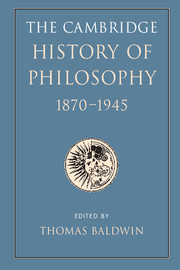Book contents
- Frontmatter
- Contents
- List of contributors
- Introduction
- I 1870–1914
- 1 Positivism, Idealism, and Pragmatism
- 2 Psychology and Philosophy
- 3 Logic, mathematics, and judgement
- 4 Philosophy and the new physics
- 5 The idea of social science
- 6 Ethics, politics, and legal theory
- 7 Philosophy of religion and art
- 24 Sceptical challenges to faith
- 25 The defence of faith
- 26 Art and morality: aesthetics at 1870
- 27 Form and feeling: aesthetics at the turn of the century
- Interlude
- II 1914–1945
- Biobibliographical appendix
- Bibliography
- INDEX
- References
27 - Form and feeling: aesthetics at the turn of the century
from 7 - Philosophy of religion and art
Published online by Cambridge University Press: 28 March 2008
- Frontmatter
- Contents
- List of contributors
- Introduction
- I 1870–1914
- 1 Positivism, Idealism, and Pragmatism
- 2 Psychology and Philosophy
- 3 Logic, mathematics, and judgement
- 4 Philosophy and the new physics
- 5 The idea of social science
- 6 Ethics, politics, and legal theory
- 7 Philosophy of religion and art
- 24 Sceptical challenges to faith
- 25 The defence of faith
- 26 Art and morality: aesthetics at 1870
- 27 Form and feeling: aesthetics at the turn of the century
- Interlude
- II 1914–1945
- Biobibliographical appendix
- Bibliography
- INDEX
- References
Summary
‘ART FOR ART’s SAKE’
The popular conception of the development of the arts at the turn of the twentieth century is dominated by the transition from naturalism to abstraction in painting and from realism to modernism in literature. The popular conception of art theory and aesthetics in this period is likewise dominated by formalism and the ideology of ‘art for art’s sake’. The painter James MacNeill Whistler (1834–1903) gave expression to both of these themes. In 1878, in his libel suit against John Ruskin, who had described him as ‘flinging a pot of paint in the public’s face’, Whistler stated that he had meant to divest the offending picture ‘from any outside sort of interest which might have been otherwise attached to it. It is an arrangement of line, form and colour first’ (Harrison, Wood, and Geiger 1998: 834–5). Such an emphasis on the sensible properties of artworks and on the formal relations among them, coupled with de-emphasis on the content of such works and their moral, political, and religious associations, is the doctrine of formalism in its most general sense.
The ideology of ‘art for art’s sake’ is the view that a special pleasure afforded by art is a necessary and sufficient condition of its value, and that art is to be neither valued nor criticised for moral, political, or religious reasons. The view is often said to have been introduced by Théophile Gautier (1811–72) in the preface to his 1835 novel Mademoiselle de Maupin, where he asserted that a novel should have no moral, political, or economic use at all, other than that of perhaps putting a few thousand francs into its author’s pocket, and that instead ‘the useless alone is truly beautiful’ (Harrison, Wood, and Geiger 1998: 98–9).
- Type
- Chapter
- Information
- The Cambridge History of Philosophy 1870–1945 , pp. 348 - 362Publisher: Cambridge University PressPrint publication year: 2003



